From spring to summer, numerous hybrids and varieties of these herbaceous plants delight with many elegant "bells" against the background of velvety leaves. Abundant flowering, original varieties, simple care and cultivation of Achimenes in almost any room are the reasons for the great interest in them. Plants are exposed on window sills or used as ampoules in wall-mounted flowerpots and hanging baskets.
Material Content:
Ahimeneses: popular varieties
Achimenes is the Latin name for the genus of flowering plants of the Gesneriaceae family. Natural species come from Mexico and other regions of Latin America. All Achimeneses are small herbaceous perennials. Species brought to Europe are characterized by beautiful flowering and transition to dormancy in winter.
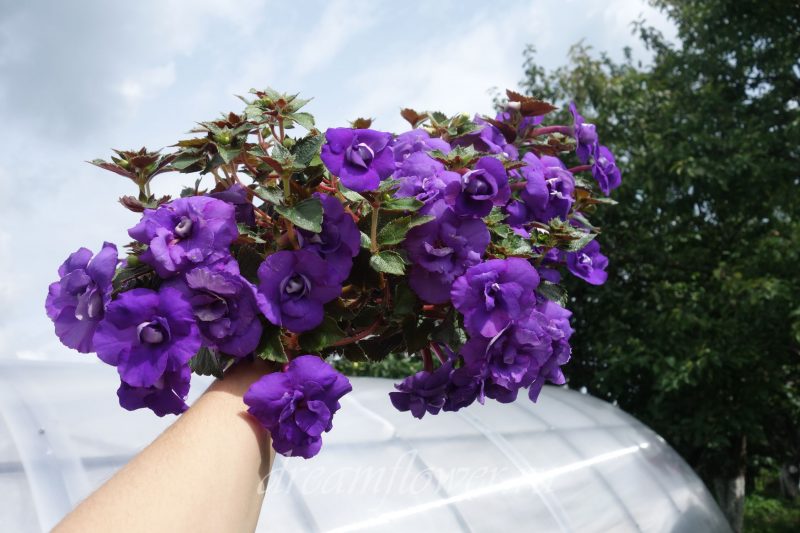
- Achimeneses have elongated brittle scaly rhizomes (rhizomes).
- The height of the aerial parts of plants is from 20 to 70 cm.
- The stems are numerous, thin, erect, slightly branching, drooping with age.
- Small dark green leaves have denticles along the edge, located opposite. The plates are rough, shortly pubescent on both sides.
The flower is quite large, blooms for only a few days. Calyx 5-lobed, usually narrow and short. A flower tube up to 5 cm long grows obliquely from the sinus of the leaf. The graceful cone smoothly or abruptly passes into the limb. The outer edge of the petals of some hybrids has a “fringe”.

A variety of new varieties of terry ahimeneses:
- Abendrot. The flowers are yellow in color with a peach tint rather large size.
- Abyss. Flowers in shades of dark blue with a light inside.
- Adelaide. A hybrid variety with white flowers up to 6 cm in diameter, with yellow and blue blotches on the petals.
- Alaska Dream. Corollas are white in color with a greenish or lavender hue.
- Anastasia. Large soft pink flowers with an orange speckled center.
- Bianco Natale. It is considered the largest white-flowered terry variety.
- Double Picotee Rose. White, bushy flowers with a light lilac hue. Related varieties: Double Blue Rose, Double Pink Rose.
- Christmas cookie. Large white flowers with a yellow center and pink strokes on the petals.
- Cytro. Pink terry flowers of large size.
- Icy Volga. The author of the variety considers him an ideal terry ahimenes. The flowers are large white, with pink-purple strokes.
- Giselle. Corollas are orange-pink with a dark spot in the center.
- Shy Sun. Lavender-white semi-double flowers. Miniature variety.
- Yellow English Rose. Huge bright yellow flowers up to 7 cm in diameter. Hues vary depending on the acidity of the substrate.
Some hybrid achimenes in a well-lit place with proper care bloom almost all year round with the exception of the rest period (4 months).
Simple ahimeneses (non-terry):
- Aquamarine Large light blue flowers with brownish strokes.
- Annie Belle. Corollas lavender.
- Arletta pink. Petals of pink color, wavy along the edge. The pharynx is yellow with brown spots. A related variety has blue flowers.
- Ambroise Verschaffelt. Ampel plant with white flowers, decorated with a blue-violet pattern and a yellow "eye". The name was given in honor of the Belgian breeder Ambroise Verschaffelt.
- Amie Saliba. Compact bush with large yellow flowers, with orange and purple bordering.
- Apricot Glow. Dark pink flowers with an apricot hue.
- Nightfall Dark red flowers.
- Clouded yellow. Corollas are dull yellow with brown blotches in the throat.
- Fallen Angel. Large white-pink flowers with a darker rim along the edge of the petals. The spot in the throat is yellow with brown strokes.
Achimenes flower attracted the attention of lovers of indoor plants in the 70 years of the last century. Then prevailed species with purple, blue and purple corollas. Over the course of several decades, hundreds of new varieties and hybrids appeared, as well as terry forms. The species used for selection are wild species: Achimenes erecta, A. longiflora, A. antirrhina, A. grandiflora.
Basic growing requirements
A lush bush needs enough light and moisture. However, the lighting should be scattered, and watering should be moderate without waterlogging of the substrate and stagnation of water in the pan. It is recommended to moisten the air on hot, dry days, especially during the formation of buds. With a moisture content of 50–70% and other requirements, the flowers reach the largest possible sizes characteristic of the variety.
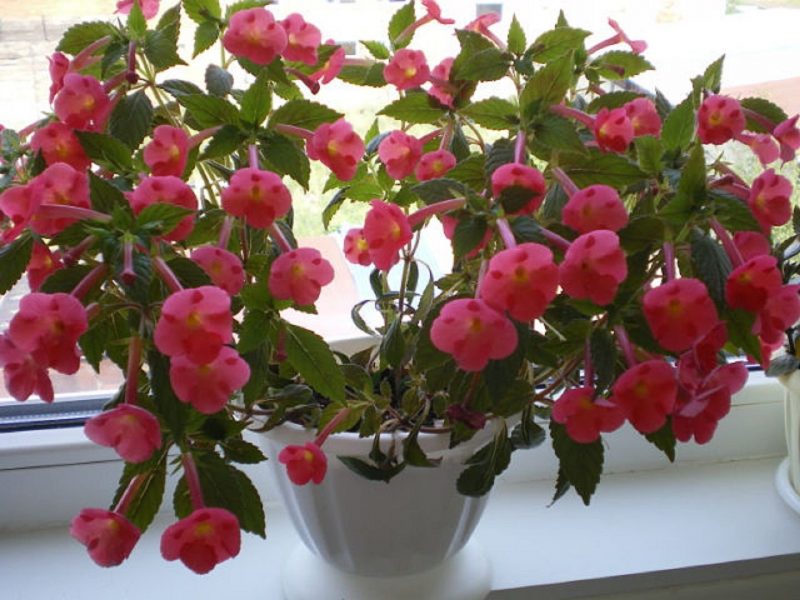
At the end of February, when young shoots appear in the form of pubescent light green "threads", Achimenes is transplanted. If necessary, divide the rhizome. If the plant is not relocated to another pot, then the upper soil layer is changed in the old one or fresh soil is poured.
Home Care
Achimeneses are kept in the warm season on a window sill protected from the midday sun, or placed in a partially shaded place in the open air (terrace, balcony). Nighttime indoor and outdoor temperatures should not fall below 15 ° C.
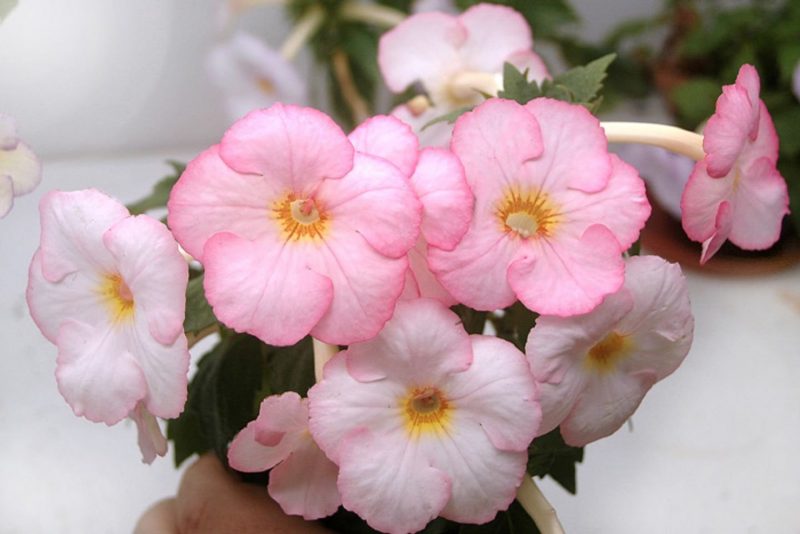
Abundantly blooming Achimeneses feel best at 18–26 ° C.
In the event of a cold snap to 12 ° C or lower, the aboveground parts of the plant may die.
Features of the content depending on the season
In spring and summer, Achimenes needs light and heat (without direct scorching sun). You can place the pots on the windowsills of the windows of the western and eastern directions. In this case, the plants receive soft sunlight in the morning or evening. Some varieties are content with a relatively small amount of lighting. Ampel forms are less demanding - partially shaded places suit them. Planters and baskets are hung by the window.
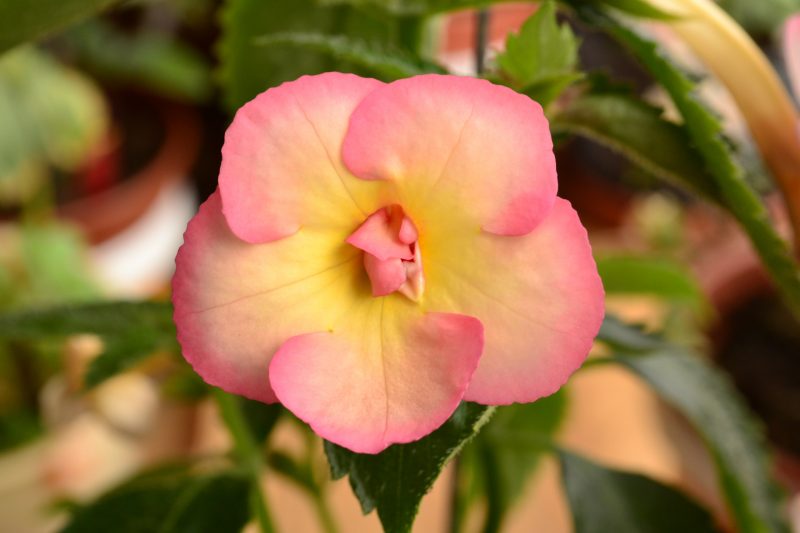
After flowering, in September or October, the shrunken aerial part of the plant is cut short, and the rhizome is left in the ground. Achimenes does not need lighting and watering during the rest period. Pots contain at temperatures from 10 to 16 ° C in October – November. Toward the end of the dormant period, watering is resumed to stimulate growth.
Watering the Achimenes
It is important that the soil is moist, well permeable to water.At the bottom, drainage is needed to prevent waterlogging. With adequate watering, many new rhizomes are formed, which in the next season give abundantly flowering shoots. Plants are sensitive to waterlogging of the soil. If part of the water comes into the pan, then it is drained immediately.

Water the flowers with water, heated to 25-30 ° C, with a low content of calcium (soft).
- Achimeneses moderately drink at the beginning of the growing season, as soon as young shoots appear from the ground. Between irrigations give the upper layers of the substrate a little dry. Inside the pot, the soil should remain moist, permeable.
- During flowering, Achimenes needs regular watering on hot sunny days.
- After flowering, they need less moisture. In September, watering is reduced, and after the death of leaves and stems, it is stopped.
Soil Composition and Pot Selection
The best substrate mix for Achimeneses is sheet land, low-lying peat and quartz sand (2: 1: 1). Pieces of charcoal are added. Be sure to pour a layer of perlite or coarse sand at the bottom of the tank. Horse peat is not recommended because of its high acidity and low nutrient content. The most suitable pH value is in the range of 5–6.5 (slightly acidic or neutral).

If the soil composition is selected correctly and there is good drainage, then the soil retains its structure for several years. Subject to the remaining care requirements, it will be possible to avoid annual transplantation and increase the plant's resistance to disease.
Fertilizer application
When planting and transplanting Achimenes, you can add 1 tbsp. l granular fertilizer compo or trio mix. Growth and development ”in each pot. The need for nutrients increases during the period of active growth. Achimans are fed once a month with a solution of complete mineral fertilizer (0.1%) or with the Fertika complex. The composition should be potassium, phosphorus, nitrogen and trace elements. Liquid top dressing begins with the resumption of growth processes.
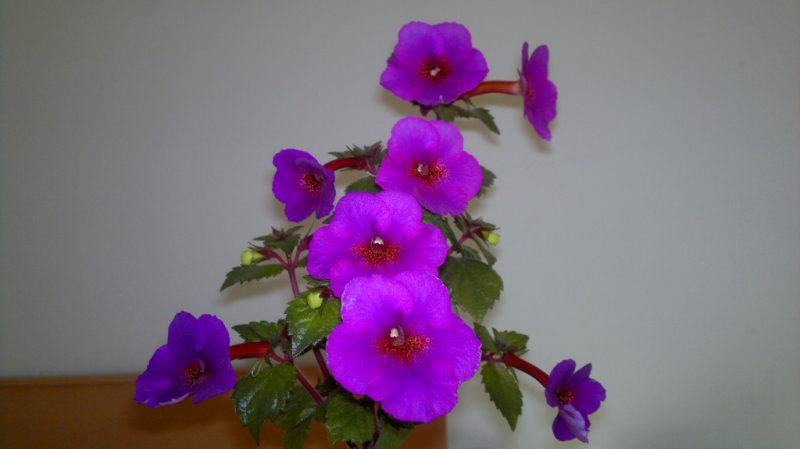
Nitrogen is most important during the formation of shoots; mineral element helps leaves gain strength. As soon as budding begins, they switch to fertilizing with flower fertilizers with a higher content of phosphorus and potassium. During the rest period, fertilizers are not needed.
Landing and transplanting
In the spring, in March, when the Achimenes starts to grow, it is transplanted into a wide pot or planter. First, a lump of earth is removed from the old tank by tapping on the bottom. Then the rhizome is freed from the soil.
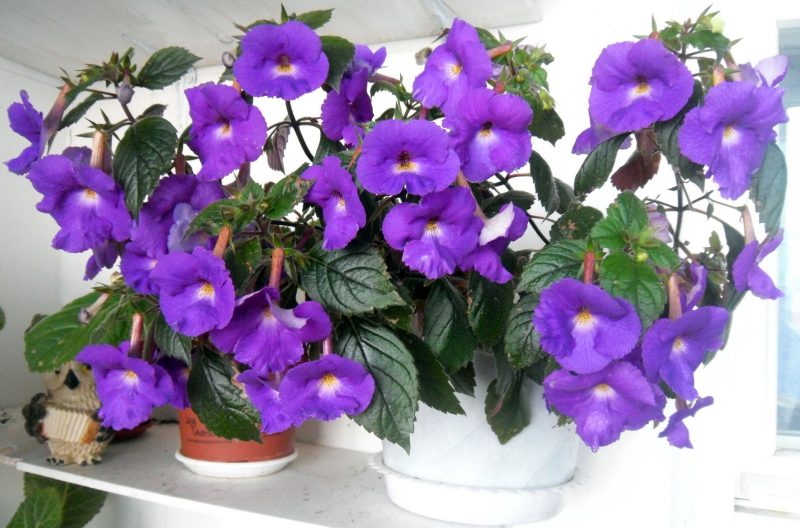
How to plant ahimenes:
- A layer of sand or gravel drainage is poured at the bottom of the pot.
- The pot is half filled with the prepared substrate.
- On the surface scatter 1 tbsp. l full fertilizer, top cover with a layer of soil.
- Rhizomes are distributed on the surface, sprinkled with a substrate 2-3 cm high.
- The soil is slightly compacted and watered with warm water.
- They contain transplanted plants in a bright place at a temperature of 20–25 ° С.
Small pieces of rhizome accidentally broken off do not throw away - they also germinate. Regular watering begins after the appearance of young shoots on the surface.
Rest period
Withering of Achimeneses and preparation for rest begins after flowering has ended. During this period, plants require minimal care. When the shoots are dry, they cut off the entire aboveground part. Achimeneses can spend a rest period in a cool room with or without windows, in the basement, on the bathroom floor, in the winter garden or in the garage, if the temperature in the selected room does not fall below 3 ° C.
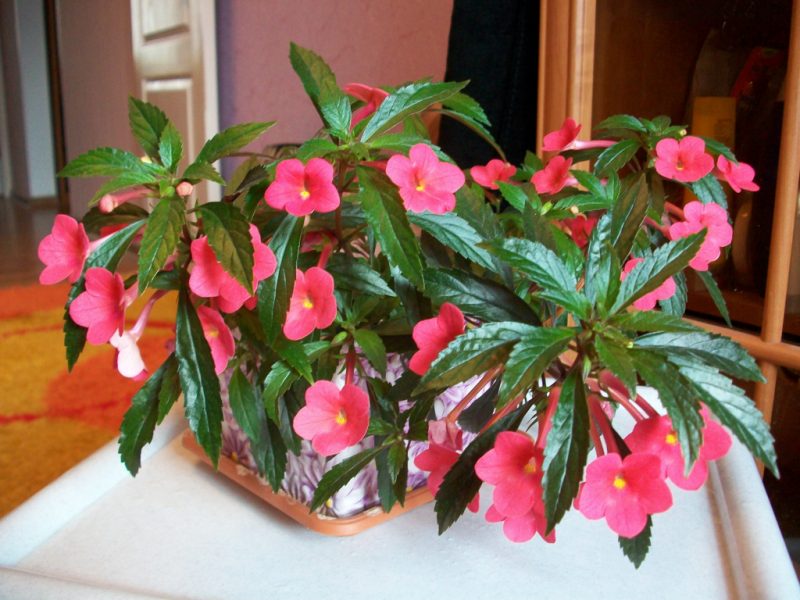
Rhizomes at rest almost do not consume water. Moisturize the soil in a pot 1 or 2 times a month so that the rhizome does not wrinkle.
By the end of the dormant period, new shoots can be stimulated by good lighting and moderate watering.
Propagation Features
By dividing the rhizomes, Achimenes is propagated from late February to mid-March.Sleeping rhizomes awaken, aboveground shoots begin to grow from them. Achimenes easily tolerates division during this period.
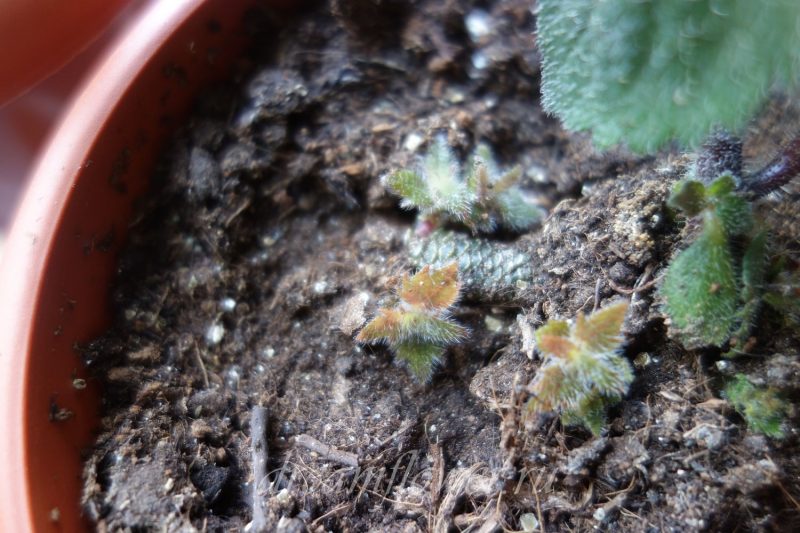
All summer the plant is propagated by green cuttings. Pieces of a stem with flowerless shoots are rooted in water or in wet sand under plastic glasses. After the roots appear, the plant is planted in a pot with soil.
Plant diseases and pests
Achimenes can attack aphids, thrips, and other harmful organisms.
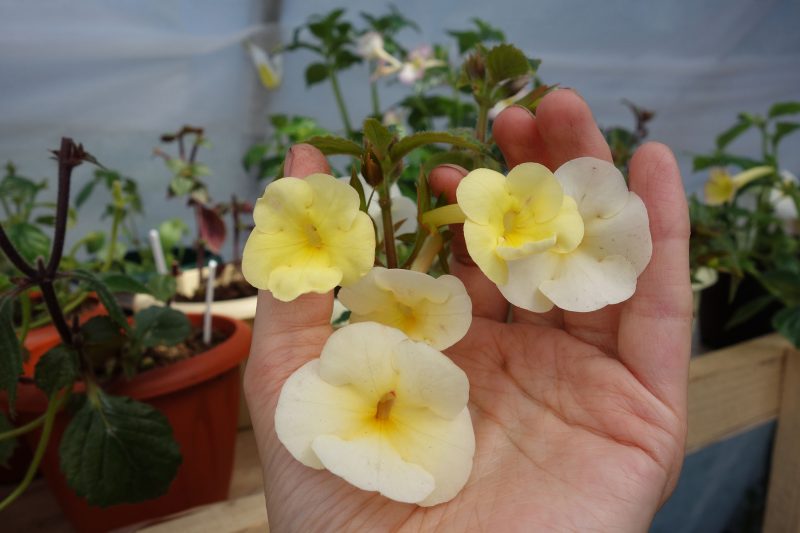
- Colonies of thrips quickly cause plant death.
- Spider mites live on the underside of leaves, suck juices from living tissues.
- Viral, fungal and bacterial infections cause great damage.
Regular inspection of leaves and buds is necessary to identify infected plants.
In the case of a viral infection, the indoor flower should be isolated, and with further progression of the disease, burn.
A common care disease - ring-shaped spots on the leaves - affects plants that are watered with too cold water or left unprotected in bright sunshine. Buds and flowers do not appear when the dormancy period is too short and when there is a lack of light after it has ended.
Why do the buds turn brown, the leaves dry and fall off?
The reason for the early fall of flower buds is a change in location, improper watering, lowering temperature, lack of nutrients. Especially sensitive to change are the new varieties of Achimenes.
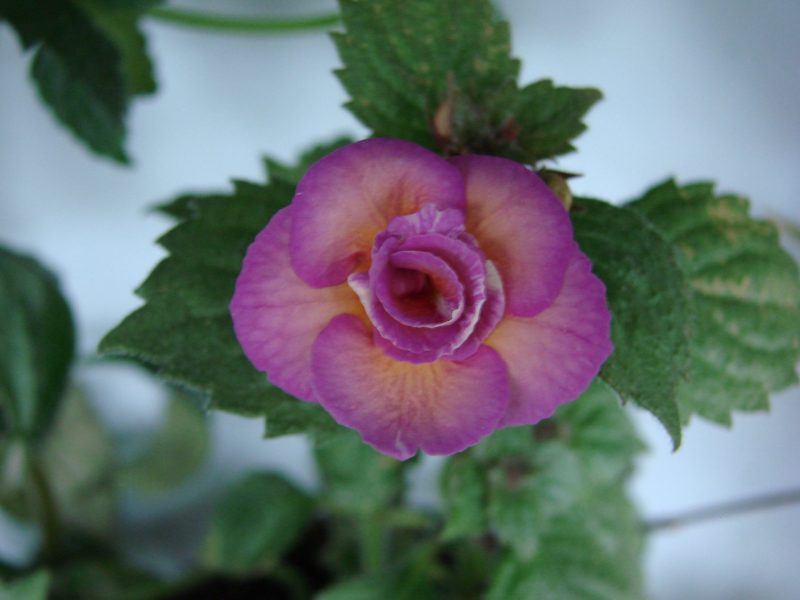
Reasons for drying and falling of leaves, turning buds:
- too low humidity;
- complete drying of the soil in the pot;
- abrupt and frequent change of location;
- thrips or spider mite attack;
- high calcium content in soil and / or water for irrigation.
If an infectious disease or pest is suspected, pesticides must be treated. The insecticidal and acaricidal preparation "Topaz" is used for aphids, ticks, and thrips. Biofungicides help get rid of the fungus.
If the problems with the Achimenes are caused by errors in care, then the situation is easy to fix. It is necessary to keep the plant in accordance with the requirements for lighting, water it and feed it in time. Fallen leaves of Achimenes in autumn is a normal occurrence. The dormant period begins, at the end of which new shoots appear.












